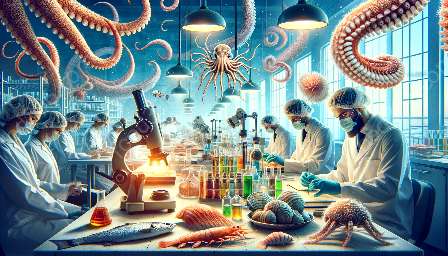Seafood quality is a critical aspect of the seafood industry, ensuring that products are safe for consumption and meet the expectations of consumers. Regulatory standards and guidelines play a crucial role in maintaining and upholding the quality of seafood products.
When it comes to seafood quality control and assessment, adherence to regulatory standards and guidelines is essential to safeguard public health and build consumer confidence. In this article, we will explore the regulatory standards and guidelines for seafood quality and their relationship to seafood quality control and assessment, as well as the intersection with seafood science.
Importance of Regulatory Standards for Seafood Quality
Regulatory standards and guidelines for seafood quality are designed to ensure that seafood products are safe, wholesome, and accurately labeled. These standards are established by regulatory bodies at the national and international levels to govern various aspects of seafood production, processing, and distribution.
One of the primary objectives of regulatory standards is to prevent the sale of contaminated or adulterated seafood products, which could pose significant risks to consumers' health. By setting clear criteria for product quality, safety, and hygiene, regulatory standards help mitigate potential hazards and protect public health.
International Standards and Guidelines
On the international stage, several organizations play a pivotal role in setting standards and guidelines for seafood quality. The Food and Agriculture Organization (FAO) of the United Nations and the World Health Organization (WHO) collaborate to develop and publish the CODEX Alimentarius, a collection of international food standards, guidelines, and codes of practice. The Codex Committee on Fish and Fishery Products (CCFFP) specifically addresses the quality and safety of fish and fishery products, contributing to the establishment of international norms for seafood quality.
Furthermore, the International Organization for Standardization (ISO) sets global standards for a wide range of industries, including the seafood sector. ISO standards cover aspects such as traceability, hygiene, and quality management systems, providing internationally recognized benchmarks for seafood quality and safety.
Seafood Quality Control and Assessment
Seafood quality control and assessment encompass a series of processes and measures aimed at verifying and maintaining the quality attributes of seafood products. These activities involve monitoring and evaluating various parameters, including sensory characteristics, microbiological status, chemical composition, and compliance with regulatory standards.
Key components of seafood quality control and assessment include:
- Inspection and Testing: Regular inspection and testing protocols are conducted to detect potential contaminants, pathogens, and other hazards in seafood products.
- Traceability Systems: Utilization of traceability systems to track the origin, processing, and distribution of seafood, ensuring transparency and accountability throughout the supply chain.
- Hazard Analysis and Critical Control Points (HACCP): Implementation of HACCP plans to identify and address critical points in the production process that could impact the safety and quality of seafood.
- Quality Assurance: Establishment of quality assurance measures to maintain consistency and adherence to predefined quality standards.
Role of Seafood Science
Seafood science plays a pivotal role in understanding the intricate aspects of seafood quality, encompassing fields such as marine biology, food technology, and food safety. Research and advancements in seafood science contribute to the development of innovative techniques for assessing and enhancing the quality of seafood products.
Integration of seafood science with regulatory standards and guidelines enables the implementation of evidence-based approaches to ensure the safety and quality of seafood. By leveraging scientific knowledge and technological advancements, stakeholders in the seafood industry can enhance their ability to comply with regulations and deliver high-quality products to consumers.
Conclusion
The regulatory standards and guidelines for seafood quality form the foundation for ensuring the safety, integrity, and quality of seafood products. Through adherence to these standards, coupled with robust seafood quality control and assessment practices and the application of seafood science, stakeholders in the seafood industry can uphold the highest standards of quality and safety, fostering consumer trust and confidence in the seafood products they offer.
As the seafood industry continues to evolve, the harmonization of regulatory standards, seafood quality control processes, and the latest scientific advancements will be instrumental in addressing emerging challenges and opportunities in the realm of seafood quality.

